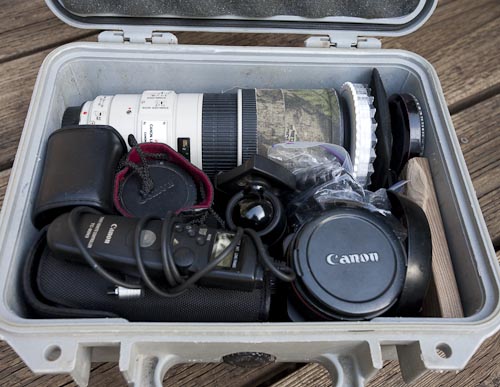
Gearing up to photograph for a ten-day trip without power—in this instance a sea kayak trip—has two obvious concerns: flash memory and batteries. You need enough capacity in both to shoot through to the finish. Still, ten days isn’t so long that you can’t keep it simple. On a recent trip around Isla Carmen in Baja, MX with Sea Kayak Adventures, I didn’t consider a solar charger, despite the dependable sun. Nor did I bring a Wolverine-type digital storage device (like Michael Reichmann, a Hyperdrive Colorspace UDMA). Cards and batteries built a simple expedition edifice.
Part of managing your time and energy on such a trip is to pack small. Use the 80-20 rule for camera gear: bring only the 20% of gear that will yield the 80% of images. So my 500mm f/4 stays home. Since the trip involves air travel, I fit all my camera gear except tripod in carry-on bags that I also use while kayaking. My Pelican 1400 case fits inside most kayaks. For the flight to Loreto, MX, it’s packed with a 300mm f/4, 24mm f/3.5 T/S, flash, polarizing filters, cleaning kit, spare batteries, ball head and a compact (homemade) kit for making panoramas. Also for carry-on, I used a fanny pack (Sagebrush Dry Goods Sure-Dry Hip Pack) to stow my 5D and 5D Mark II camera bodies, and two lens—the 70-200mm f/4L and 17-40 f/4L. While kayaking, the cameras (with lens choice for the day) are in separate waterproof Sagebrush Dry Goods bags inside the cockpit. This gives me plenty of quick shooting options from the seat of the kayak.
Compact flash cards are cheap now, and save space as well. Before the trip, I purchased a two-pack of Sandisk 4GB cards. That brought me to 32 GB of compact flash—mostly in 4GB cards—and enough, I reasoned, for the 10-day trip. I estimated I’d shoot 1500-2000 images, split 50-50 between my new Canon 5D Mark II and the old 5D. The 5D II is 21MP. I would shoot RAW as usual, which meant I could be pushing the memory limit. Batteries, however, were a greater concern. If you run out of memory but have ample power, you can always take the minor risk (and time cost) of erasing bad or marginal images in-camera to free up space. But if you’re batteries are drained—days or miles from a re-charge—you’re done.
I had 5 batteries (BP 511) for the old 5D, charged and ready. The new 5D II takes a different-shaped, “smart” battery (LP-E6), so the BP 511’s don’t fit. Canon suppliers had the LP-E6 price at about $90 each. Instead, I purchased a single, third-party battery with charger for $33 through e-Bay (similar batteries can be found as of 5/20/09 for $21). This battery performed as advertised: it worked fine, but with no charge indication on the camera LCD, and a warning to charge it with the supplied charger only.
The trip promised pleasant weather, and dry desert air. Morning shoot temperatures at 60F, daytime highs at 80+F, and evenings about 70F—temperatures nice for conserving power. By the end of day two, the battery icon on my 5D II read 86% after shooting 165 images. I had power to spare. On a couple of evenings I reviewed images, popping cards from both camera into the old 5D so as not to burn up the 5D II batteries. Amazingly, at day 7, I was still using the first battery on both cameras, and had used them both about equally. The old 5D said I had plenty of charge left after 470 images. The 5D II indicated I had 34% charge left after 653 images. I was ahead of the game, so I spent a bunch of 5D II battery with a 19-minute star-trail shot. Complete with noise-reduction (doubling the exposure time), it took the battery indicator down to 5%. (In retrospect, I should have popped in a fresh battery before that shot, as I could have lost the exposure, and possibly more, but ohh, that day we finished paddling at 1pm, and by 3pm trip-member Angelo had set up a sort of impromptu happy hour stand, where the group quickly downed most of his tequila).
Knowing the battery charge in tiny increments is an advantage on trips like this. The battery icon on the 5D only indicates full, low or replace. The 5D II reports remaining charge in 1% increments, and records picture count for individual batteries even if you’re swapping them in and out. You can forecast power use, and track and estimate where you’ll be.

At the end of my trip I had 2+ GB of remaining compact flash. I depleted two batteries from the 5D; 1-1/2 from the 5D II. The 5D logged 621 images; the 5D II, 878 images; for a total of 1,499. I shot my morning and evening, tripod-mounted stuff, including one star-trail, with the 5D II. On the water, I used the 5D for wide-angle shooting out of one dry bag, and in the other bag on the 5D II, I had either a 70-200mm f/4 or 300mm f/4 w/1.4x attached. Putting the long lens on the bigger pixel camera gave me more latitude later for cropping wildlife shots. In retrospect, I can’t think how I’d do anything different. And I’m amazed that—with judicious shooting—I could stretch this simple kit to two-weeks without power.
You can view some of the April, 09 Baja trip images in my Adventure section at Around Isla Carmen.
Gary